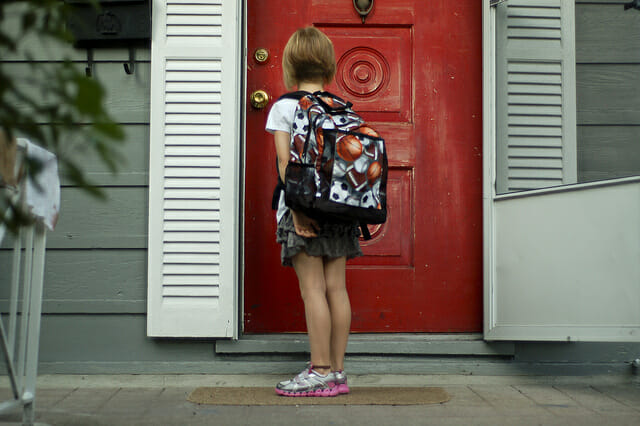Can you believe it’s almost time for school to start?
With the first day looming, we thought it would be a good time to discuss concerns physical therapists have about school backpacks. Every day, children use backpacks to carry books and supplies back and forth from school and between classes. Many children carry very heavy packs, and parents often question whether the weight, or use of backpacks in general, may be contributing to back pain or postural changes in our children’s spines.
Several research studies since the late 1990s have considered the problems with use of backpacks for school-age children.
Some of these studies discuss the weight limitations that we might use to prevent back pain. Other studies looked at the use of one-shoulder versus two shoulder backpacks to prevent postural deformities.
The big concern for physical therapists is whether the prolonged use of backpacks in school-age children leads to pain or postural deformities such as scoliosis or kyphosis. Scoliosis is defined as a sideways curve of the spine. It most often occurs in the thoracic spine (area around the ribs), and/or the lumbar spine (low back). Scoliosis results in a posture with one shoulder lower than the other and one hip lower than the other when standing upright. It is seen as a hump on one side of the ribs in a spine when a person bends forward to touch their toes. Kyphosis is the forward deviation of the spine, usually the thoracic spine, resulting in a “hump” seen from the side with a posture of the head and shoulders leaning forward when standing upright.
Recent studies indicate that there is a cause for concern with use of backpacks when kids are still growing.
In general, we recommend limiting the weight of the pack to 10-15% of a child’s body weight and wearing the pack on two shoulders (not one shoulder) to keep the weight distributed evenly. The backpack should also be worn lower on the back, just above the hips, versus higher at the shoulder or rib level. However, it’s not only the weight or how the pack is worn, but how long a child wears the weighted pack over the course of the day and weeks during the school year that effects the development of neck/back pain or postural alignment over time.
One product that allows a person to carry books without carrying the load on the back is called the BackTpack. Developed by a physical therapist, the BackTpack has two packs on either side of the body with a shoulder harness similar to a traditional school backpack.
School Backpack Tips
Choosing a School Backpack
- Select a pack with well-padded 2-inch wide shoulder straps. Shoulders and necks have many blood vessels and nerves that can cause pain and tingling in the neck, arms, and hands when too much pressure is applied.
- School backpacks come in different sizes for different ages. Choose the right size pack for your child as well as one with enough room for necessary school items.
Loading a Backpack
- A child’s backpack should weigh no more than about 10% of his or her body weight. This means a student weighing 100 pounds shouldn’t wear a loaded school backpack heavier than about 10 pounds.
- Choose light material (canvas as opposed to leather).
- Load heaviest items closest to the child’s back (the back of the pack).
- Arrange books and materials so they won’t slide around in the backpack.
- Check what your child carries to school and brings home. Make sure the items are necessary for the day’s activities – often, kids lug things around that they really don’t need.
- If the backpack is too heavy or tightly packed, your child can hand carry a book or other item outside the pack.
- If the backpack is too heavy on a regular basis, consider using a book bag on wheels if your child’s school allows it.
Wearing a Backpack
- Distribute weight evenly by using both straps. Wearing a pack slung over one shoulder can cause a child to lean to one side, curving the spine and
causing pain or discomfort. - Adjust the shoulder straps so that the pack fits snugly on the child’s back. A pack that hangs loosely from the back can pull the child backwards and strain muscles.
- Wear the waist belt if the backpack has one. It helps distribute the pack’s weight more evenly.
- The bottom of the pack should rest in the curve of the lower back. It should never rest more than four inches below the child’s waistline.
Karolee Stauduhar and Toula McCarty, Physical Therapists








